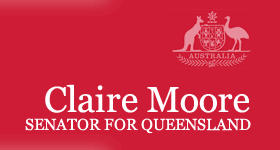Senator MOORE (Queensland) (6:10)—
The Australian aid agency AusAID has released its new guiding principles for family planning and the aid program. There has been much discussion around this particular change in policy and I was really keen to put on record exactly what is now going to be the Australian policy and to clarify any misconceptions about what is in our policy and how we are going to move forward.
The guiding principles have been developed to reflect the International Conference on Population and Development’s program of action, which was adopted 15 years ago in Cairo. This program of action defined reproductive health as:
… a state of complete physical, mental and social well-being and not merely the absence of disease or infirmity, in all matters relating to the reproductive system and to its functions and processes.
The ICPD actually put forward a 20-year plan for action with a vision that people across our world would be healthy. The ICPD called for countries to support the following principles: to ensure that comprehensive and factual information and a full range of reproductive health care services, including family planning are accessible, affordable, acceptable and convenient to all users; to enable and support responsible voluntary decisions about child bearing and methods of family planning of their choice, as well as other methods of their choice, for regulation of fertility that are not against the law, and to have the information, education and the means to do so; to meet the changing reproductive health needs over their life cycle and to do so in ways sensitive to the diversity of the circumstances of local communities; to make appropriate steps to help women avoid abortion, which in no case should be promoted as a method of family planning, and in all cases provide for the humane treatment and effective counselling of women who have had recourse to abortion; ensure in circumstances where abortion is not against the law that such abortion is safe and, in all cases, women should have access to quality services for the management of complications arising from abortion; and that very professional and effective post-abortion counselling, education and family planning services should be offered promptly, which will also help again to avoid repeat abortions.
It is so important that we do have effective guidelines so that people are not confused. It also aids our aid program working with donors and NGOs to effectively provide what we should be doing to face the enormous challenge that we have now under the Millennium Development Goals. I have spoken many times in this chamber about the challenge of the Millennium Development Goals and, particularly, about Millennium Development Goal 5 and also 5A, which looks quite specifically at maternal and child health. Why is this so important? We have made a commitment as a world to address these issues and we have seen, this far down the track, that we are falling badly behind. Of all the Millennium Development Goals, Millennium Development Goal 5 is the one where our neighbours are doing most poorly. That is a great shame. What we must do—and there are reasons to take action—is invest in women. This will produce far-reaching economic and social benefits.
We know estimates are just that, but the UN has estimated that the world loses $15 billion in productivity every year because of maternal and newborn mortality. We must ensure that there are targeted investments in maternal, newborn and reproductive health. This will have a dramatic, lasting effect on the economic and social fabric of all nations, in particular developing nations.
We have acknowledged as a world that maternal health is a human right. Maternal deaths are a gross violation of women’s human rights. Governments, including ours, have an obligation to protect women’s right to life, health and equality, and the fulfilment of those rights is essential to reducing maternal mortality. We know, through the studies across the world, that maternal health and newborn health are closely linked, and we know that in poor countries—and even in our own—a mother’s death after childbirth is often a death sentence for her newborn child, and not just for a first child. Studies have proved that the loss of a mother in any family can have ongoing effects both on poverty and development for all children of that family. So it is an issue for all of us. Providing good quality care during and after pregnancy and childbirth can drastically reduce newborn mortality as well.
We as a world know through our commitment that MDG 5 and 5a can be achieved, but we must have the political will and financial investment. Delivering a package of services is essential to making significant improvements to maternal health—and it has been costed at less than US$1.50 per person in the 75 countries where 95 per cent of maternal mortality occurs. I know that they are just a series of figures, but they show just how small an amount of money individually can make such a significant change. That is nowhere more important than it is in our neighbouring countries. Papua New Guinea, Timor Leste and a range of other areas through Asia and the Pacific are all addressing these problems, and we have a role to play in supporting that.
We know what we must do. There is no magic about the solutions. We must have cost-effective health strategies that will save mothers’ and newborns’ lives. The great majority of maternal and newborn deaths can be prevented through simple, cost-effective measures. Complications in pregnancy and childbirth are common everywhere, but they are not unpredictable.
Governments and the international community must commit together to the following actions needed to provide essential services to all women in developing countries, to meet MDG 5 by 2015—and remember, Mr President, 2015 is not that far away. We must increase investment in maternal, newborn and reproductive health, and that means looking at aid programs from all donor nations, because no one country can support this alone. What we have learnt is that cooperation among donor nations, which is being effectively put in place in many countries at the moment, will be an advantage, and that means that the best resources can be used and utilised. Rather than it being some form of competition and complication, we can actually work together on this—and I know this is a key issue in our aid program across all areas, not just in maternal health. Effective cooperation and focus of resources must be a key issue for all of us.
We need to strengthen the general health systems in countries, because maternal health is one part of a health system. We have to sustain and scale up critical health interventions. In addressing the absolutely serious gaps that we have in the workforce, we must look at all elements of healthcare professionals. Of course we look at doctors and nurses, but also across some areas of Asia and the Pacific we are looking at what is known as a ‘skilled birth attendant’. That is someone who has local knowledge, has a degree of skill, has the trust of the local community and, most importantly, can be there with the woman before, during and after she gives birth so that there is safety and security and the birth process is a joy and something that can be celebrated rather than—as it is in all too many cases—something that represents loss and death in the community.
We must also look at strengthening maternal, newborn and reproductive health programs and institutions, and ensure that information and services are sensitive to and respectful of women, especially poor and marginalised women. This includes making sure that we have effective cultural knowledge and do not impose a culture from the outside. How many programs have been unsuccessful because of our lack of real cultural sensitivity and hence a lack of trust at the local level? We need to work effectively with communities so that we share the responsibility, and we need to respect women and their families no matter where they are.
As always, in any program—and we are talking about a significant funding investment here—we need to develop monitoring and accountability mechanisms and channels for community engagement that address wider socioeconomic, political and cultural barriers to maternal and newborn health care, improve policies and programs, and then make sure that we review them constantly so that we are not lost because something has been bypassed—that we work together to see that the best use of resources is made.
This is not a difficult process, but it is a real challenge for all of us. I think we have the opportunity to deal with these issues. I know that across the world we are saying we can meet MDG 5 and 5a. If we do not, we have not succeeded. As I have said in this place before, no woman should die in the process of giving life.




